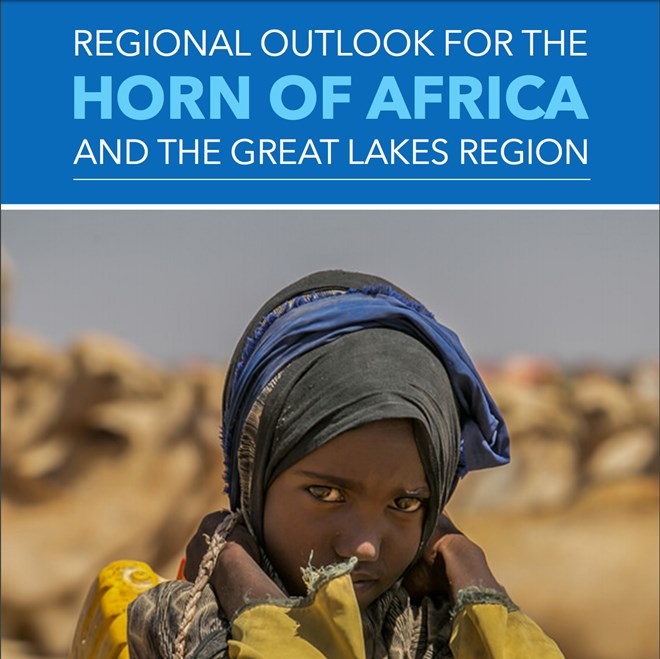
Friday February 24, 2017

Executive Summary
This report has been developed collectively with humanitarian partners in the region to inform preparedness and advocacy efforts to mitigate and manage humanitarian risk in the Horn of Africa and Great Lakes region*. It presents a three-month trend analysis from October to December 2016 and a humanitarian outlook from January to March 2017. It is the sixth report in the series and updates the previous scenario report which was published in October 2016.
Regional Trends: October-December 2016
The number of people in crisis and emergency food insecurity levels (IPC 3 or above) and in need of humanitarian assistance in the Horn of Africa region has continued to grow in 2016, reaching an estimated 21.4 million people at the end of the year. This represents a 30 per cent increase compared to 16.4 million in January 2016. Needs are driven by successive episodes of drought, which have led to consecutively failed harvests, combined with conflict and insecurity, and economic shocks affecting the most vulnerable.
The impact of the drought is largely comparable to the El Niño-induced East African drought of October - November 2010, which caused a regional food security and nutrition crisis in 2011. Extensive crop failures and record low vegetation, together with significant livestock deaths, are currently observed across Somalia, southern and eastern Ethiopia, and northern and coastal Kenya. Western Kenya, parts of south-western Ethiopia, parts of southern Sudan and the central and eastern part of Uganda are moderately affected. Pasture and water resources for human and livestock consumption are at critically low levels across wide swathes of the region, particularly between Somaliland and southern Ethiopia.
The coping mechanisms of the most vulnerable households are already stretched after the second year in a row of poor livestock and crop productivity. Whereas government response capacity is much greater compared to 2010/11 and governments have allocated significant funds to meet growing humanitarian needs (Ethiopia US$780 million in 2016 and Kenya US$99 million in 2017), the scale of the current crisis is outpacing existing capacity.
Acute malnutrition in children under five years remains a major concern in many parts of South Sudan, Ethiopia, Somalia, Sudan, Democratic Republic of Congo (DRC), Kenya and Uganda. Acute malnutrition and anaemia among refugees are of huge concern, especially as due to shortfalls in funding food ration have been significantly cuts. Global Acute Malnutrition(GAM) prevalence in ten out of 24 camps in Ethiopia exceeds the 15 per cent emergency threshold. Anaemia is above the 40 percent of public health significance in at least nine out of 24 camps. Over 75 percent of the Somali refugee children who have arrived in Dollo Ado in Ethiopia since January were acutely malnourished.
In Burundi, the number of people in need of humanitarian assistance increased in 2016 from 1.1 million to at least 3 million (26 per cent of the total population) – with displaced women, children and youth being the most affected. Protection needs have almost doubled, from 1.1 million to 1.8 million people. The socio-political crisis impacted on the rule of law and on access to essential support services, thus exposing the most vulnerable to multiple protection risks, including gender-based violence.
Conflict has been the major cause of displacement across borders and a threat to peoples’ security. According to UNHCR, as of January 2017, there were 4 million refugees and asylum seekers in the region. The majority of the newly displaced come from South Sudan. More people have fled South Sudan since July 2016 than Syria in the whole of 2016. There are now more than 1.9 million people are internally displaced, and more than 1.54 million have left to seek refuge in neighboring countries as a result of insecurity and food insecurity. Around 240,000 Sudanese refugees living in South Sudan since 2011 are exposed to continued insecurity. In eastern DRC continued armed conflict and inter-communal violence has led to the displacement of an additional 178,000 people since September 2016. This brings to total number of internally displaced people in the DRC to 2.1 million. Since October 2016, 64,000 Burundians fled to neighbouring countries bringing the total number of refugees to 364,000 (since 2015).
Simultaneous disease outbreaks persisted with cross-border implications, including yellow fever, malaria, cholera and measles, challenging the region’s already overstretched healthcare facilities. Spikes in malaria cases were reported in Burundi, South Sudan and eastern DRC. According to WHO, more than eight million Burundians were affected by malaria in 2016, some 3,800 of whom died.
Funding gaps hampered the humanitarian response in the region. Overall funding needs in 2016 were US$6.7 billion, which was 66 per cent funded. Refugee appeals were the worst funded and consequently the World Food Programme (WFP) was forced to make food ration cuts in Kenya (50 per cent), South Sudan (30 per cent) and Ethiopia (20 per cent). In addition, food rations for South Sudanese refugees in Uganda were cut by 75 per cent, due to a very serious US$62 million food assistance funding gap (December – May 2017).
Humanitarian space continued to be constrained across the region due to insecurity, bureaucratic impediments and financial limitations. The volatile and insecure operational environment in South Sudan, Somalia, Sudan and eastern DRC made it especially difficult and costly to respond to growing needs. There were access constraints in parts of Eritrea, some areas in Sudan remain inaccessible, and in Burundi access impediments, in particular administrative, were on the rise.
Click here to review the full report